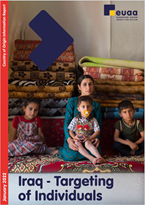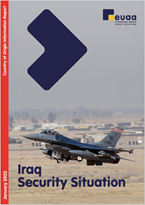INTRODUCTION
Last updated: June 2022
The country guidance is developed in accordance with Article 11 of the EUAA Foundation Regulation (EU) No. 2021/2303. It represents the common assessment of the situation in the country of origin by senior policy officials from EU Member States, in accordance with current EU legislation and jurisprudence of the Court of Justice of the European Union (CJEU).
This guidance does not release Member States from the obligation to individually, objectively and impartially examine each application for international protection. Each decision should be taken on the basis of the individual circumstances of the applicant and the situation in Iraq at the moment of the decision, according to precise and up-to-date country information, obtained from various relevant sources (Article 10 of the Asylum Procedures Directive).
The analysis and guidance provided within this document are not exhaustive.
Below, you can learn more about the country guidance methodology and how this document was developed:
Why is this country guidance developed?
The country guidance is intended as a tool for policy-makers and decision-makers in the context of the Common European Asylum System (CEAS). It aims to assist in the examination of applications for international protection by applicants from Iraq, and to foster convergence in decision practices across Member States.
On 21 April 2016, the Council of the European Union agreed on the creation of a senior-level policy network, involving all Member States and coordinated by the European Union Agency for Asylum (EUAA), with the task to carry out a joint assessment and interpretation of the situation in main countries of origin.[1] The network supports EU-level policy development based on common country of origin information (COI), by jointly interpreting such information in light of the relevant provisions of the asylum acquis and taking into account the content of the EUAA training material and practical guides where appropriate. The development of common analysis and guidance notes is now included as a key area in the new mandate of the EUAA and it is currently regulated under Article 11 of the EUAA Regulation.[2]
[back]
Is this guidance binding?
The country guidance is not binding. However, in accordance with Article 11 of the EUAA Regulation, Member States have the obligation to take into account the guidance notes and common analysis when examining applications for international protection, without prejudice to their competence for deciding on individual applications.
[back]
What is the scope of this update?
The current version of the guidance updates and replaces the ‘Country Guidance: Iraq’ (January 2021).
This update mainly focuses on the chapters of subsidiary protection (Article 15(c) QD) and internal protection alternative, as well as on the following profiles: persons (perceived to be) affiliated with ISIL, Sunni Arabs, human rights and political opposition activists and protesters, journalists and media workers, (perceived) collaborators of Western armed forces, organisations or companies, individuals perceived to transgress moral codes, individuals considered to have committed blasphemy and/or apostacy, religious and ethnic minorities and stateless persons, women and persons involved in and affected by blood feuds in the context of tribal conflict.
Minor changes have also been introduced in other parts of the horizontal framework of the document. These changes do not generally impact the assessment of the situation in Iraq as per the previous version of the guidance from January 2021.
[back]
Who was involved in the development of this country guidance?
This document is the result of the joint assessment by the Country Guidance Network, whose work was supported by a Drafting Team of selected national experts and by EUAA. The European Commission and UNHCR provided valuable input in this process.
The guidance note, accompanied by the common analysis, were finalised by the Country Guidance Network in May 2022 and endorsed by the EUAA Management Board in June 2022.
[back]
What is the applicable legal framework?
In terms of applicable legal framework, the common analysis and guidance note are based on the provisions of the 1951 Geneva Convention[3] and of the Qualification Directive (QD)[4]; as well as on jurisprudence of the Court of Justice of the European Union (CJEU); where appropriate, the jurisprudence of the European Court of Human Rights (ECtHR) is also taken into account.
[back]
What guidance on qualification for international protection is taken into account?
The horizontal guidance framework applied in this analysis is based primarily on the following general guidance:
EUAA Practical Guide: Qualification for international protection

EUAA Guidance on membership of a particular social group
EUAA Practical guide on the application of the internal protection alternative
EUAA Practical Guide: Exclusion
These and other relevant EUAA practical tools can be found at https://www.euaa.europa.eu/practical-tools.
Relevant UNHCR guidelines are also taken into account.[5]
[back]
What country of origin information has been used?
The EUAA Country Guidance documents should not be considered and should not be used or referenced as sources of COI. The information contained herein is based on EUAA COI reports and, in some instances, on other sources as indicated. Unlike the Country Guidance, these represent COI sources and can be referenced accordingly.
This update is mainly based on the following recent COI:

COI Report: Iraq
Key socio-economic indicators (November 2021)
Annex II. Country of origin information references provides further details and links to all COI reports used as a basis for this analysis. References within this document are to the respective sections of these COI reports.
In addition, relevant country of origin information from UNHCR on access and residency requirements in Iraq[6], issued in January 2021 has been taken in consideration in the ‘COI Report: Iraq – Key socio-economic indicators (November 2021)’.
This guidance should be considered valid as long as current events and developments fall within the trends and patterns observed within the reference period of the respective COI reports. New developments that cause substantial changes and result in new trends may impact the assessment provided in the present guidance. All effort is made to update the EUAA COI reports and country guidance documents regularly and to reflect any such significant changes accordingly. Individual applications should always be assessed in light of the most up-to-date available COI.
To access EUAA COI reports, visit https://www.euaa.europa.eu/country-reports.
[back]
How does country guidance assist in the individual assessment of applications for international protection?
The guidance note and common analysis follow the steps of the examination of an individual application for international protection. This document looks into the relevant elements according to the QD and provides a general assessment of the situation in the country of origin, along with guidance on relevant individual circumstances which should be taken into account.
[back]
How is this document structured?
The country guidance is structured into guidance note and common analysis:
The GUIDANCE NOTE is the first part you will find in this document. It summarises the conclusions of the common analysis in a light user-friendly format, providing practical guidance for the analysis of the individual case.
The COMMON ANALYSIS is the second, more detailed, part. It defines the relevant elements in accordance with legislation, jurisprudence and horizontal guidance, summarises the relevant factual basis according to the available COI, and analyses the situation in the respective country of origin accordingly.
For additional information and to access other available country guidance, see https://www.euaa.europa.eu/country-guidance.
[1] Council of the European Union, Outcome of the 3461st Council meeting, 21 April 2016, 8065/16, available at http://www.consilium.europa.eu/media/22682/st08065en16.pdf.
[2] Regulation (EU) 2021/2303 of the European Parliament and of the Council of 15 December 2021 on the European Union Agency for Asylum and repealing Regulation (EU) No 439/2010, available at https://eur-lex.europa.eu/eli/reg/2021/2303/oj.
[3] United Nations General Assembly, 1951 Convention Relating to the Status of Refugees and the 1967 Protocol Relating to the Status of Refugees.
[4] Directive 2011/95/EU of the European Parliament and of the Council of 13 December 2011 on standards for the qualification of third-country nationals or stateless persons as beneficiaries of international protection, for a uniform status for refugees or for persons eligible for subsidiary protection, and for the content of the protection granted.
[5] UNHCR Handbook and guidelines on procedures and criteria for determining refugee status under the 1951 Convention and the 1967 Protocol Relating to the Status of Refugees, as well as other guidance, policy documents and UNHCR ExCom and Standing Committee conclusions are available at https://www.refworld.org/rsd.html.
[6] UNHCR, Iraq: Relevant Country of Origin Information to Assist with the Application of UNHCR's Country Guidance on Iraq: Ability of Persons Originating from Formerly ISIS-Held or Conflict-Affected Areas to Legally Access and Remain in Proposed Areas of Internal Relocation, January 2021, available at https://www.refworld.org/docid/5ffc243b4.html


